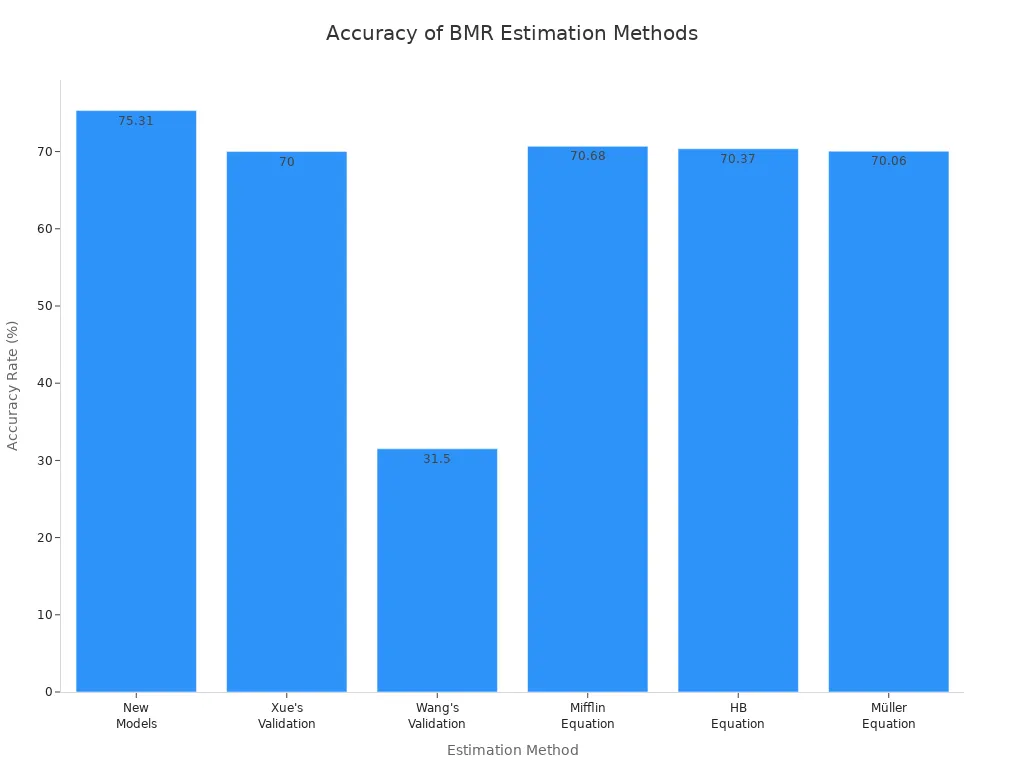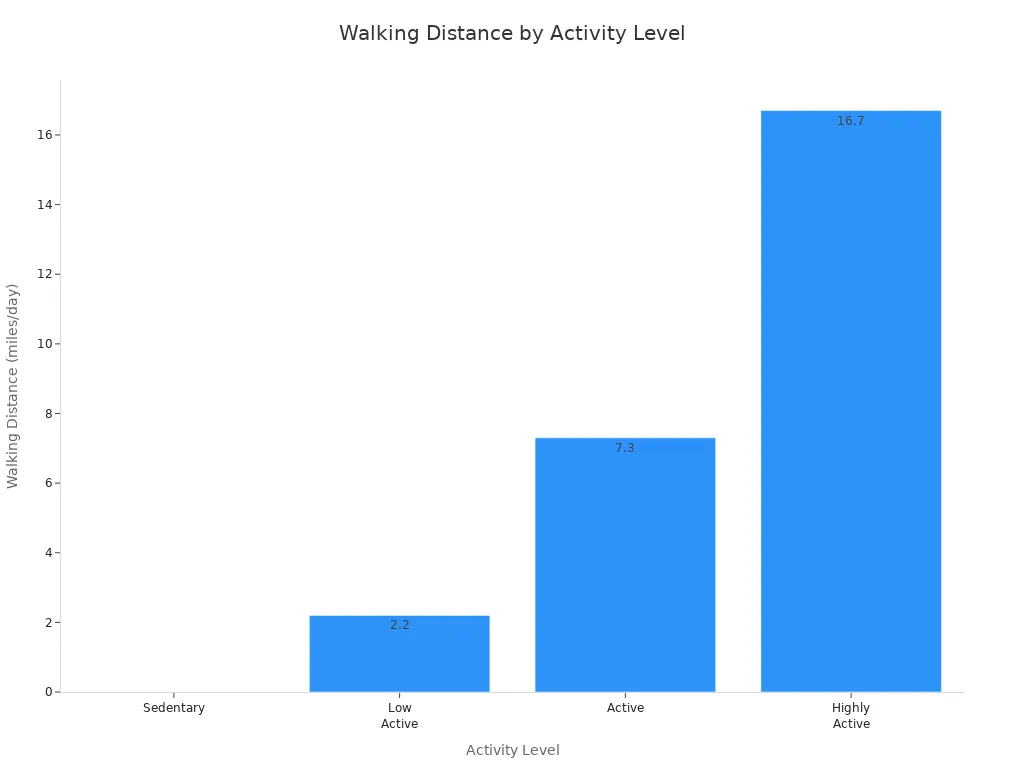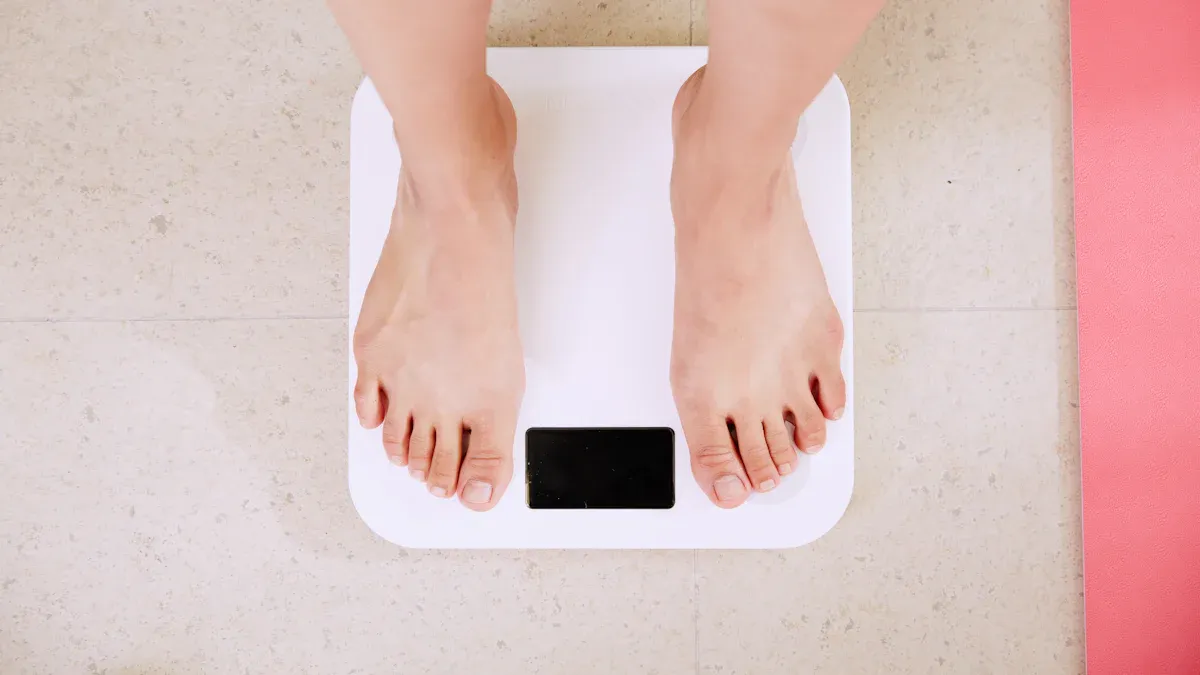BMR Calculator to Lose Weight
This BMR calculator gives you a personalized weight loss plan based on your age, height, weight, and gender. Get your BMI, daily calorie needs, meal guide, and workout plan—all in one place.
BMR Calculator
You want a plan that actually works for fat loss. A bmr calculator gives you a starting point by showing how many calories your body needs at rest. Knowing your bmr helps you set accurate goals for weight loss, so you can track your weight and make every step count toward your loss.
Key Takeaways
-
Knowing your Basal Metabolic Rate (BMR) is very important for losing weight. It lets you make the right calorie goals for your body.
-
Use a BMR calculator to make finding your daily calories easier. Put in correct facts like your age, weight, height, and gender to get the best answer.
-
Eat fewer calories than your Total Daily Energy Expenditure (TDEE) to lose weight. Try to eat 300 to 500 fewer calories each day for safe and steady weight loss.
What Is BMR?
Your body needs energy to keep you alive, even when you rest. This energy is called your basal metabolic rate, or BMR. It covers the calories you burn for basic things like breathing, blood flow, and keeping your body temperature steady. BMR also supports cell growth, brain function, and muscle movement. You use BMR every day, even if you do nothing but sit on the couch.
Why BMR Matters
You might wonder why BMR is so important for weight loss. BMR makes up a big part of your daily calorie burn. When you know your BMR, you can figure out how many calories you need to eat to lose, gain, or keep your weight steady. Here are some reasons BMR matters:
-
It lets you plan meals and workouts that fit your needs.
-
Knowing your BMR can help you avoid eating too little or too much.
Studies show that adjusting your calorie intake based on BMR leads to better weight loss results and helps you keep the weight off.
|
Study |
Findings |
Implications |
|---|---|---|
|
Ravussin et al., 1988 |
Low metabolic rate adjusted for body mass predicts long-term weight regain. |
Adjusting calorie intake based on BMR is crucial for sustainable weight loss. |
|
Muller et al. (2016) |
Observed a -108 kcal/d metabolic adaptation after 50% calorie restriction. |
Highlights the need for ongoing adjustment of calorie intake post-weight loss. |
|
Bosy-Westphal et al. (2013) |
Metabolic adaptation was lower EE in individuals who regained weight. |
Suggests that understanding BMR can help maintain weight loss. |
How to Estimate Your BMR
You can estimate your BMR in a few ways. The most common method uses equations like the Harris-Benedict or Mifflin-St Jeor formulas. These ask for your age, weight, height, and gender. Some online calculators use these formulas to give you a quick answer. Scientists have tested different methods for accuracy. Check out this chart to see how they compare:

If you want to know how to estimate your bmr, start with an online calculator or use a simple formula. Just remember, these tools give you an estimate. Your real needs may change based on your body and activity.
Calculate Your BMR
Using a BMR Calculator
You want to make things easy, so you reach for a bmr calculator. This tool helps you figure out how many calories your body burns at rest. You just enter your age, weight, height, and gender. The calculator does the math for you and gives you your basal metabolic rate. This number is important because it makes setting your calorie goals much simpler.
Many people use online calculators because they are quick and convenient. You do not need to know any formulas or do any math. Here are some of the most popular bmr calculator options and what makes them different:
|
Calculator Name |
Formula Used |
Key Features |
|---|---|---|
|
Harris-Benedict Equation |
BMR = 88.362 + (13.397 × Weight in kg) + (4.799 × Height in cm) − (5.677 × Age in years) |
Widely used, considers age, weight, height, and gender. |
|
Mifflin-St Jeor Formula |
BMR = 10 × Weight in kg + 6.25 × Height in cm − 5 × Age in years + 5 (Men) / -161 (Women) |
Considered the gold standard, improved accuracy and simplicity. |
|
Katch-McArdle Equation |
BMR = 370 + (21.6 × Lean Body Mass in kg) |
Focuses on lean body mass, highly accurate for athletic individuals. |
|
BMR Calculator for Weight Loss |
Not specified |
Helps users understand their caloric needs for weight management. |
|
Best BMR Equations |
Not specified |
Discusses various BMR equations and their applications for energy needs estimation. |
Tip: Knowing your bmr helps you take the guesswork out of your calorie needs. You can use this number to plan your meals and workouts for better weight loss results.
When you use a bmr calculator, make sure you enter your details as accurately as possible. Your age, weight, height, and gender all affect your results. Even small mistakes can change your number a lot. For example, if you overestimate your activity level, your calorie needs may look much higher than they really are. Many people think they are more active than they are, so try to be honest about your daily routine.
Here are some things that can affect your bmr calculator results:
-
Activity Level: Most people pick a higher activity level than they actually have. This can make your calorie goal too high.
-
Body Composition: Standard calculators do not know how much muscle or fat you have. Muscle burns more calories than fat, so people with more muscle have a higher bmr.
-
Self-Reported Inputs: People often guess their weight or height. Try to use recent and accurate numbers for the best results.
How to Calculate Your BMR
If you want to know how to calculate your bmr by hand, you can use a formula. The two most common ones are the Harris-Benedict and the Mifflin-St Jeor equations. These formulas use your age, weight, height, and gender to give you your basal metabolic rate.
Here is a simple step-by-step guide:
-
Find your weight in kilograms, your height in centimeters, and your age in years.
-
Pick the right formula for you:
-
For men:
BMR = (10 × weight in kg) + (6.25 × height in cm) – (5 × age in years) + 5 -
For women:
BMR = (10 × weight in kg) + (6.25 × height in cm) – (5 × age in years) – 161
-
-
Plug your numbers into the formula and solve.
Let’s look at what affects your bmr:
|
Factor |
Impact on BMR |
|---|---|
|
Age |
Decreases by 1-2% every decade after age 20 |
|
Gender |
Men have a higher BMR than women |
|
Height |
Included in BMR calculation |
|
Weight |
Included in BMR calculation |
|
Body Composition |
Strongly influences BMR |
Note: Your bmr makes up about 60%-70% of your total daily energy use. If you have more muscle, your bmr will be higher.
Tips for Accurate Input
-
Always use your current weight and height.
-
Double-check your age and gender before entering them.
-
Be honest about your activity level. Most people overestimate this.
-
If you know your body fat percentage, use a calculator that lets you enter it for better accuracy.
Pros and Cons of Each Method
|
Method |
Advantages |
Disadvantages |
|---|---|---|
|
Manual Calculation |
More personalized, lets you see how each factor affects your bmr. |
Takes more time, you need to know the formulas and do the math. |
|
Online Calculator |
Fast, easy, no math needed. |
May not be as accurate for everyone, does not consider all factors. |
-
Manual calculations can give you a more personal estimate, but they take longer.
-
Online calculators are fast and simple, but they may not be perfect for everyone.
No matter which method you choose, remember that your bmr is just a starting point. Your real calorie needs can change as your weight, activity, or body composition changes. Use your bmr calculator as a guide, not a rule. This way, you can adjust your plan as you go and get the best results for your weight loss journey.
Set Your Calorie Goal
Setting the right goal is the heart of your weight loss plan. You already know your bmr, but now you need to figure out how many calories you burn in a day. This helps you create a plan that matches your daily calorie needs and keeps you on track for your goal.
Find Your TDEE
Your Total Daily Energy Expenditure (TDEE) tells you how many calories you burn each day, including all your activities. You get this number by multiplying your basal metabolic rate by an activity factor. This step is key because it helps you set a daily calorie goal that fits your lifestyle.
Here’s how you can find your TDEE:
-
TDEE estimates the calories you burn daily, including physical activity.
-
You calculate TDEE by multiplying your bmr by a factor between 1.2 and 1.9, depending on how active you are.
-
TDEE is your bmr adjusted for your daily activities, so it gives you a more complete picture of your daily calorie needs.
To pick the right activity factor, look at your usual routine. Use this table to match your activity level:
|
Activity Level |
PAL Range |
Walking Distance (miles/day) |
|---|---|---|
|
Sedentary |
1.0 - 1.39 |
0 |
|
Low Active |
1.4 - 1.59 |
2.2 |
|
Active |
1.6 - 1.89 |
7.3 |
|
Highly Active |
1.9 - 2.5 |
16.7 |

Let’s say your bmr is 1,500 calories. If you are low active, you multiply 1,500 by 1.5. Your TDEE would be 2,250 calories. This number is your starting point for your plan.
Tip: Be honest about your activity level. Most people overestimate how much they move. Picking the right factor helps you set a realistic goal.
Create a Calorie Deficit
Now that you know your daily calorie needs, you can set a goal for weight loss. The main idea is simple: you need a calorie deficit. This means you eat fewer calories than your body burns. When you do this, your body uses stored fat for energy, leading to weight loss.
The science behind this is called energy balance. If you take in fewer calories than you use, you lose weight. Most experts suggest a deficit of 300 to 500 calories per day. This helps you lose about one pound per week, which is a safe and steady pace.
Here’s how you can create a calorie deficit:
-
Subtract 300 to 500 calories from your TDEE to set your daily calorie goal.
-
You can reach this deficit by eating less, moving more, or both.
-
Focus on a balanced diet to keep your body healthy while you lose weight.
For example, if your TDEE is 2,200 calories, you can set your daily calorie goal at 1,700 to 1,900 calories. This plan helps you lose weight without feeling starved.
Note: Avoid cutting your caloric intake too much. Going too low can slow your metabolism, cause fatigue, and even lead to health problems.
If you set your deficit too high, you risk:
-
Diet rebound, weight regain, and a slower metabolism.
-
Eating disorders or unhealthy thoughts about food.
-
Hormonal problems, especially for women.
-
Poor athletic performance and more injuries.
-
Getting sick more often.
-
In extreme cases, serious heart problems.
A healthy plan keeps your caloric deficit in the safe range. You want to lose weight, but you also want to feel good and stay healthy. Stick to your goal, track your progress, and adjust your plan as needed. Remember, your bmr and daily calorie needs can change as you lose weight, so check your numbers every few weeks.
Your plan should help you reach your goal, not make you feel weak or sick. A steady, balanced approach works best for long-term weight loss.
Track and Adjust

Monitor Progress
You want your plan to work. You need to check your progress often. Tracking weight and fat loss shows if your plan fits your bmr and calorie needs. You can weigh yourself every day, once a week, or every two weeks. Some people like daily checks to see small changes. Others feel less stress with weekly weigh-ins.
|
Frequency Recommendation |
Notes |
|
|---|---|---|
|
Weighing yourself |
Daily, weekly, or bi-weekly |
Daily checks catch changes, weekly checks may lower stress. |
|
Food and activity logs |
Log food and exercise often |
Knowing what you eat helps you change habits. |
|
Self-weighing frequency |
Pick what feels best for you |
Some like daily checks, others want less often. |
You can use apps to help you track. Here are some popular ones:
-
MyFitnessPal: Tracks protein, fat, and calories. It helps you learn about food.
-
FatSecret: Free calorie tracker with meal plans and a barcode scanner.
-
Cronometer: Good for athletes or people with special diets.
-
Lose It!: Simple app for weight management and fat loss.
Avoid Common Mistakes
Many people make mistakes that slow down fat loss. Watch out for these:
-
Not tracking drinks like soda or juice.
-
Guessing calories burned during exercise.
-
Measuring food differently each time (raw or cooked).
1. Only looking at the scale can be confusing. Your weight can change for many reasons. 2. Eating too much or too little can hurt your progress.
Try these tips to avoid mistakes:
-
Track all food and drinks for a while to learn about your intake.
-
Use measuring cups and a food scale for accurate portions.
-
Set a goal, check your habits, and change your plan if needed.
-
Get help from friends or groups.
-
Be ready to change your plan if your bmr or activity changes.
Changing your calorie intake as you go helps you follow your plan. This supports safe and steady weight loss.
You can lose weight by following these steps: calculate your bmr, set a calorie goal, and track your progress. Remember, bmr calculators give you a starting point, not a strict rule. Stay consistent, adjust as needed, and celebrate small wins. You have the power to take control of your health!
FAQ
How often should you recalculate your BMR?
You should check your BMR every few months or after losing 10 pounds. Your calorie needs change as your weight and activity level change.
Can you use a BMR calculator if you are a teenager?
Yes, you can use a BMR calculator. Just remember, teens grow fast. Talk to a doctor or nutritionist before making big changes to your diet.
What if your weight loss stalls?
Try tracking your food and activity more closely. You may need to adjust your calorie goal or add more movement. Small changes can restart your progress.
